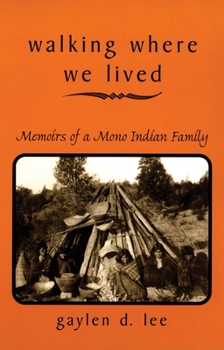Walking Where We Lived: Memoirs of a Mono Indian Family
Select Format
Select Condition 
Book Overview
The Nim (North Fork Mono) Indians have lived for centuries in a remote region of California's Sierra Nevada. In this memoir, Gaylen D. Lee recounts the story of his Nim family across six generations. Drawing from the recollections of his grandparents, mother, and other relatives, Lee provides a deeply personal account of his people's history and culture. In keeping with the Nim's traditional life-style, Lee's memoir takes us through their...
Format:Hardcover
Language:English
ISBN:0806130873
ISBN13:9780806130873
Release Date:October 1998
Publisher:University of Oklahoma Press
Length:224 Pages
Weight:1.04 lbs.
Dimensions:0.8" x 5.8" x 8.9"
Customer Reviews
4 ratings
A Fascinating Read
Published by Thriftbooks.com User , 16 years ago
Gaylen Lee has offered a gem! This non-linear memoir is so thoughtfully written that it provides delicate insight into the history and life of the Mono Indians while wrapping you in the story along the way. Pulled along through the text you want to read more but not without appreciating each step. This is a true treasure.
An important book for Mono culture.
Published by Thriftbooks.com User , 21 years ago
As a Mono Indian, I have nothing but words of praise for Gaylen Lee's work. He begins by saying that he only speaks for himself, which is important since our families' experiences are all so different depending on contact and acculturation. I am grateful that this book was written, as it is something all people can read, appreciate and gain understanding of a California tribe.
By, not about, an Indian
Published by Thriftbooks.com User , 25 years ago
The reader hears the authentic voice of a tribe of Indians of the US far west. Lee knows his people's language and uses Native words liberally. He exlains attitudes and concepts that were at such odds with white thinking that it made the Indians vulnerable to domination. He does not apologize for his people's culture. Adults whose knowledge of Indian life may have ended with elementary school social studies will find this book astonishing
This book is rich with detail about a Calif. Indian family.
Published by Thriftbooks.com User , 26 years ago
Non-Indians reading "Walking Where We Lived" may have to re-think everything they once believed about California's indigenous population. On the eve of the state's sesquicentennial celebration, Gaylen D. Lee offers a view of the Gold Rush and subsequent settlement of California by Americans and immigrants that is clearly, from his perspective, nothing to celebrate. But Lee's book is hardly a whining narrative of the atrocities suffered by the native people of California. Instead, it is a celebration of his family and families like them who have managed to survive and perpetuate their culture, religion, and values despite the onslaught of intruders. Following the pattern of the seasons, Lee describes the lives of his ancestors, historical events which affected them, their loss of freedom, and the endurance of a way of life in the face of generations of adversity. "Walking Where We Lived" is rich with detail. Lee's description of the daily activities of his family and forbears is based upon knowledge passed to him and actual experience. As a child he accompanied his family to gather acorns, berries, and plant materials. He watched the women make baskets which he says are still used in his home. He learned to hunt and fish in the old way. Although he understood English, he spoke only the Nim language prior to beginning kindergarten in the mid-1950s. The generally peaceful life lived by the Nim and their fellows all over California was shattered as Americans moved to claim every inch of the new state following secession of the territory by Mexico and the world-famed gold rush. Stories of the Mariposa Indian Wars in the spring of 1851, and other skirmishes are generally told from the point of view of Central California settlers eager to rid their new land of pesky savages. "Walking Where We Lived" offers a view from the other side. It is not surprising for a man in Gaylen Lee's situation to be angry, and anger surfaces occasionally in his book. The region surrounding his life-long home place was once traversed freely by his ancestors. Now the land is fenced off and paved over. Rivers are dammed. Animals which once lived with and helped sustain the people are seldom seen. What is surprising, in the face of generally accepted lore about the Indians of California, is that Lee's family-and others-have maintained their culture and sense of community despite near annihilation.





